Sources of Energy[edit | edit source]
We distinguish the main operation here by the obtaining of the molded object, auxiliary finishing operations, and polishing.
Main Operation[edit | edit source]
Charcoal, coal, gas and fuel oil has been used for these production processes. In sub-Saharan Africa there is a tendency to use the first, as it is a traditional fuel. This is also the fuel used by our by our Cameroonian partner. And for now, it can be justified for the following reasons:
- Known fuelsource in these regions, generally adopted for home use, so technically easy to use for all
- Regularity of supply independant of constraints such as power outages, which may be frequent, and which have the effect of interrupting the process of merging
- Technically, it does not require delicat maintenance equipment reserved for a specialized workforce
- Reduced installation costs
- Pollution caused by its employment, is reduced
- Availability and cost on the market are often better than that for coal and gas ..
Regulating the temperature of the process is more difficult to achieve. That is one reason why gas and liquid fuels are often more expensive to buy in Africa, they are preferred in processes of industrial facilities.
Ancillary operations[edit | edit source]
Only the furnace fans, the finishing machines and lighting of the premises require a electricity grid. A network of ~ 220V, 35 or 60 should suffice.
Characteristics of the raw materials[edit | edit source]
Metal[edit | edit source]
This is waste of variety of objects. It is therefore difficult to characterize them chemically with precision. In addition to aluminum, they also contain other elements, metallic or other. However, we can distinguish the waste which are likely to contain alloy elements. These are generally heavy, with a specific high density: engine parts of vehicles, such as housings.
Sand[edit | edit source]
The supply of sand should not pose a big problem in sub-Saharan Africa. A sand which any potter can acquire is appropriate. A test such as the one suggested here can already give strong indications about its essential qualities:
- Permeability to gas at the casting
- Cohesion, so as to avoid that grains may detach during the casting
- Easily deformable, plastic when aluminum is contracted on cooling.
For the measurement of moisture content, a not too expensive measuring device with calcium carbide may be used, the procedure is described as well in paragraph 4.2.1
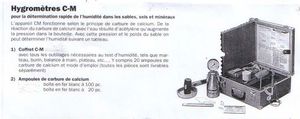
The moisture content is adjusted prior to molding; it may be more effectively evaluated prior to molding by taking a handful of sand that is ready to use. When tightly pressed in the hand, the hand must open, clearly revealing the imprint of the fingers.
Small products[edit | edit source]
Talc and wood ash, finely ground can serve as an insulation bonding between the model and the <<à vert>> sand.
Water[edit | edit source]
It is only necessary to adjust the sand content in order to obtain a gas permeability, and plasticity.
Finishing[edit | edit source]
In their molded state according to the "source" technique, the pots must be deburred to the level of their outer edge. This deburring as well as a cutting of the casting drop, the channel and the attacks are sufficient. They do no longer require much more work polishing the outer surfaces or interior surfaces.
Tools[edit | edit source]
Hand tools:
- Teeth saw pointing forward in the path to follow
- Curved teeth lime for soft metals or preferably sand paper.
- Holding mandrel if the piece is a pot.
- A light sanding can make an extra shine, if this is necessary, both to the the outer surface as the interior.
- Rotary tool with abrasive corundum, grit 80, or paper of the same type.
- If the piece is a pot, it can be maintained while holding it with a turning point chuck claw. Claws grasping the edge of the pot. The paper is kept in contact with the surface of the pot by hand.
Machines[edit | edit source]
- 1 older head with metal tour, with a rotating speed of about 200 rpm and 1 kw power will suffice.
- 1 adapted teethed chuck claw
Profits[edit | edit source]
Only a selling price established under known conditions which are determined accurately can be taken into account. This is something which could not be achieved in the conditions observed in Cameroon in August 2003. The values in the table below are therefore subject to change. As a reference, the selling price of two cookers has been identified in the large area of Nikki to Mokolo-Yaoundé, in the same period. We may thus consider that with the suggested methods and procedures, the selling price should certainly not be higher than that of the Cameroonian producers. The quality of the piece obtained raw from the foundry is far superior to that of the products prepared artisanally and sold on the Cameroonian markets. The main gain is retrieved in the reduction of work in the finishing of the pieces.
Ø
Quantity of primary matter
Price of of primary matter
Worktime
Charcoal
Returns
Selling price of the artisan
Selling price in Nikki
cm kg FCFA FCFA FCFA FCFA FCFA 20 2 1000 350 300 1650 2000 30 4 2000 500 400 2900 3500 4750 32 5 2500 700 400 3600 4500 5100 37 7 3500 900 500 4900 6000
Staff Taking into account the observations made in Cameroon, it is estimated that, in Cameroon, a facility producing 400 kg of pots of Ø 300 per week would provide direct employment to 6 manual workers, full or part time. Cost of labor at 8/03: 3500 FCFA per day. Matter Cost of scrap at 8/03: 500 FCFA/kg
APPENDICES[edit | edit source]
Appendix 1: Machinery and Tools[edit | edit source]
Type of machine Quantity Features Current (A) Total cost € Band saw 1 220V 7 3000 Double ribbon sander 1 220V 0.750 350 Degassing tube 2 SiC 354 Vertical sieve 1 mesh 50 * 20 mm² 21.3
- 6*1m²
Tools Casting sieve 2 100 Canvas for casting sieve 1 m² Bandage roll 1 Bandage glue 1 Saw blades 10 265 2 nitrogen bottles Nitrogen injection can 2 400 Device to measure humidity 1 923 Total 5413 Pricing as of 6/2004
Appendix 2: Degassing[edit | edit source]
For critical parts or to obtain a better surface appearance of the parts, it is necessary to degas the molten metal before pouring. Different techniques are used to this end, the most appropriate in the current context uses nitrogen gas.
Degassing with nitrogen gas At the end of the merger, the heating of the melting pot is stopped or moderated by the decision of the ventilation of the furnace, which initiates the lifting of the dirt to the surface of the bath.
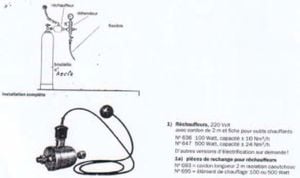
You may also proceed to immersion of pellets generating nitrogen at the end of the melting. Precautions to take: the gas and the pellets must be absolutely anhydrous.
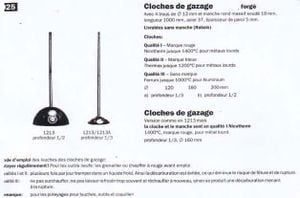
To limit the import of expensive consumption materials, the first solution is often preferable, even if the injection rods have a certain fragility. Duration: Allow 5'/100 kg of molten metal.
Controlling the degree of degassing The mixture which is melted and possibly ready to pour, is submitted to a precise checking of its temperature which has to be kept constant at ± 5° C. An efficient degassing can only take place if the melting pot is transferred to a separated furnace, heated by oil or gas.
Appendix 3: Sorting of scrap[edit | edit source]
The following elements may be used to determine the likely composition of the metal.
By appearance[edit | edit source]
Presence of rust: ferrous metal Gray look while oxidized: zinc Whitish appearance when oxidized: aluminum or magnesium Yellowish/reddish appearance: copper alloy
By its use[edit | edit source]
Boxes of light tools such as chain saws: aluminum alloy Sole of an iron: aluminum alloy Light kitchen utensils: aluminum alloy Profiles of window frames: aluminum alloy Car wheels and enjoliveurs: aluminum alloy High voltage electric cables: aluminum alloy Engine blocks and gear boxes of Volkswagen cars: magnesium alloy Car parts: pumps, electrical boxes cast under pressure: zinc alloy Engine pistons: aluminum alloy Non-magnetic electrical parts, shaft bearings, valve parts: cupper alloy Pieces of heavy machinery, engine blocks, agricultural machinery: ferrous metal Regular electrical wires: copper alloy Water pipes: steel or copper; distinction in appearance Springs, electrical contact parts, bearings for rotating shafts: copper alloy or tinned steel Gutters: zinc Battery plates, insulated electric cables: lead Carburetor of car engines, pumps, electrical boxes: zinc
Appendix 4: Traditional casting[edit | edit source]
Ground molding for drop casting by means of a single frame[edit | edit source]
This is the easiest method to make the mold. It is used especially in India, Egypt and sub-Saharan Africa (Cameroon, Benin, ...) but only gives a quality with poor surface finish. We prepare by making the ground surface flat, kind of a flange. The marmitemodel is filled with sand, well tamped with the rammer. It is made on top of it, with the opening downwards, we will have a part of the sand emptied in order to reduce the weight. Insulation such as talc or crushed wood ash is sprinkled on the mound which is also formed. A frame is placed around the pot as a model with sloping channel and a tube or a round brush, model for the flow channel. The molding sand is packed into the frame. We fix with some strokes the position of the frame relative to the sole. The frame, which accompanies the pot is unmoulded, the model is separated from the mold frame. Finally the frame is again placed on the sole and the sod takes care of the repérage. The process is illustrated in the appendix.
Particular uses:
- for simple pieces and pieces of large dimensions for which the time for solidification is limited, can this method be useful
- With a rehausse, or enlargement of the metal, the quality of the workpiece can be improved; it can remove the dross which is formed during the casting more effectively
- For certain pots, of hemispherical shape, the mold can be achieved in two or three pieces to avoid the handling charges of becoming too heavy.
- The quality, and appearance of the surface will be less good, but the pencil events are locatable, if necessary, for the evacuation of the gas flow.
Sketch of a traditional Cameroonian mold for a pot of Ø 30 cm[edit | edit source]
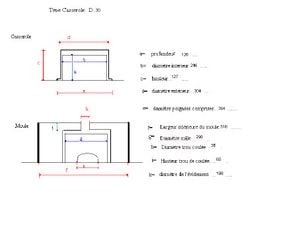
Appendix 5: Creation of a clay/graphite melting pot[edit | edit source]
The literature on the subject often suggests ancient formulas for this fabrication, which sometimes seems anecdotal on one side, but effective, using a mixture of sand, clay, graphite, bran, and cow dung.
Appendix 6: Color of metal depending on temperature[edit | edit source]
Color Temperature barely visible 630° C Visible 675° C Dull red, dull 775° C Dark red 850° C Bright red 990° C
Appendix 7: Test of source casting of a skillet[edit | edit source]
The casting test was carried out on a skillet of the model Tefal1 by means of two frames.
Mold for the skillet Figure 37 represents an unfinished molded pan from Yaounde and the replica of this was made in Belgium and and its description is given above as well as the used mold. Description of the test: source casting of a skillet of this type. Sheet of the test: Item: skillet Dimensions: Ø exterior 260 mm H 20mm handle Al + plastic L, 170 mm, slightly inclined l, 25 mm riveted base thickness 3.5 mm slightly sloping lateral sides, height: ~20 mm Model: skilet of Tefal/Armatal brand
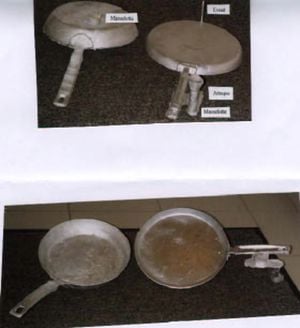
Purpose of the test: source casting of a skillet of this type Alloy: ASG3 Sand: chemical granulometry ~ 95 AFS Workshop: Divry-Bertrand Date: Week of 7 June 2004 Mold: 2 frames
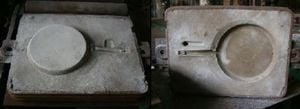
Steel frame: 500*400, H 225 mm Source casting, slightly leaning, handle side Casting hole: Ø 20
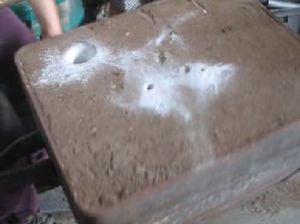
Casting slope 60, mounted on a tronconical funnel: H25 Ø 34 Fed by handle
Flow channels: half-cylinder Ø 18, L 65 Attack of channel at a right angle to the handle, length 16 connected to the handle on a width located 50 to 90 from the end of the handle. Event: on the opposite side of the handle, Ø 5 L 70 Vent smooth surface on top of 18 Surface ext. and bright interior
Appendix 8: Diversification of the products[edit | edit source]
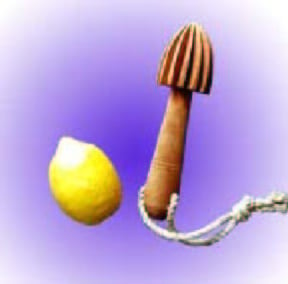
This current file was focused mainly on the manufacturing of kitchen utensils for pots. The suggested techniques can be used for much more products, such as for:
- Mechanical parts: pulleys, wheel discs (see cover photo)
- Medals, identification tags and other decorative objects
- More special kitchen utensils, such as ladles, pots on 4 feet, such as the ones used in Egypt, or ladles (see cover photo). With a little ingenuity or artfulness, it is possible to achieve:
- A round-walled pot as in Benin (see cover photo on the far right), which requires a mold in several pieces
- A manual citrus press which is more common in Asia, see for example, the model shown in this document and we have also seen a copy casted in Al.
- Alters to exercise the muscles of the hand with springs, the latter offcourse in steel mountable afterwards.
- Spoked wheels for trucks (see Figure 1).
- sheaves
Appendix 9: References[edit | edit source]
- Irmann (R.)La Fonderie d'Aluminium en Sable et en Coquille, trad.Moiroud (J.), Paris, Dunod, 321 p.
- Le Breton (H), 1955, Pour le Fondeur d'Alliages légers, Paris, Dunod, 248 p.
- Nicolet (A) et all, 1954, Le Modeleur-Mécanicien, Paris, Eyrolles, 360 p.
- Fabart (A E), 1926, Manuel du Fondeur, Paris, Librairie J.B. Baillère et Fils, 416 p.
- Laurat (Ph) , 2001,Mise au point d'une gamme de foyers améliorés et réchauds et préparation de la diffusion, Ndjamena, AEDE, 35 p.
- Goovaerts (L) et all, 2001,Beste beschikbare technieken voor de Gieterijen, Gent, Academia Press, 328 p.
- Fonderie G.Fallais, 2003, divers documents commerciaux et techniques reçus en consultation, Villers-Le-Bouillet
- Hitchings (R), 1985, How to make cutting-shears for sheet metal, London,Intermediate Technology Publications, 22 p.
- Dudouet (M),1980, Fonderie Memento de Technologie de Moulage- en Moules non-permanents, Paris, Syndicat général des Fondeurs de France, 90 p.
- Sandam (R)et all, 1967, Metalwork, London, Edward Arnold, 256 p.
- Documents du Centre Technique des Industries de la Fonderie (CTIF), France.
- Documents commerciaux des sociétés M.C.Technics, Sival, Deby, Bouvier Technofour, etc.
- Le Breton (H.),1955, Pour le Fondeur dAlliages légers, Paris, Dunod, 248 p.
- Nicolet (A. et R)., Brodbeck (G.),1954, Le Modeleur-Mécanicien, Paris, Eyrolles, 360 p.
- De Smet (G.),1972, La Pratique des Traitements themiques des Métaux industriels, Paris,
Dunod, 529 p.
- Dennis ( W.H.), 1963 2d 2e éd., Metallurgy of the non-ferrous Metals, London, Pitman, 790p.
- Razous (P.), 1949 5e éd., Théorie et Pratique du Séchage industriel, Paris, Dunod, 259 p.
- Hirst (S.), repr. 2002 , Metal Casting Appropriate Technology in the small Foundry, London, ITDG Publishing , 227 p.
- Feinberg (W.), repr. 2002, Lost Wax Casting A Practitioners Manual, London, ITDG Publishing, 74 p.
- Gingery ( D.J.), rev. 2002, The Charcoal Foundry, Rogersville (MO.USA),David J.Gingery Publising L.L.C.-
- Cosack+Co, Taco Crucible Service, Neheim-Hüsten 1 (RFA)
- Chastain (S.), 2002, Oil-Fired tilting Furnace, Jacksonville (FL.USA), 192 p.
- Navy Department-Bureau of Ships, United States Foundry Manual, 1944 repr. 1957, Lindsay Publications Inc., 291 p.
- International Correspondence Schools, 1906, repr.1983, Secrets of Green-Sand Casting, Lindsay Publications Inc., Bradley( IL.USA), 167 p.
- Harper (J.D.), 1981, Small Scale Foundries for Developing Countries, ITDG,London.
- Gingery (V.), 1986, Making Crucibles, Paperback David J.Gingery Publishing.
- Relf (C.), Scrap Metal Recovery, An Experience of intermediate Technology in Papua New Guinea, IT Publications
- ?, ?, Aluminium Kookpotten, Atol, 5 p.
- Defrancq (Ch.), 2005,Les Défauts de Fonderie générés par le Sable,Origines et Remèdes, Groupe de Travail Wallonie-Bruxelles, Seraing, Edition Enseignement Supérieur-Perspectives nouvelles, 14 p.47
- Dejonghe (M.), 2005, Les Défauts de Fonderie générés par le Sable,Expériences pratiques, Groupe de Travail Wallonie-Bruxelles, Seraing, Edition Enseignement Supérieur-Perspectives nouvelles, 11 p.
- Marchioni(B.), 2005, Les Défauts de Fonderie générés par le Sable, Expériences pratiques, Groupe de Travail Wallonie-Bruxelles, Seraing, Edition Enseignement Supérieur-Perspectives nouvelles, 38 p.
- Bellanger (G.), 2005,Conception et Tracé des Pièces de Fonderie en Fonte et en Acier, Seraing, Edition Enseignement Supérieur-Perspectives nouvelles, 55p.
- And many other documents found on the Web